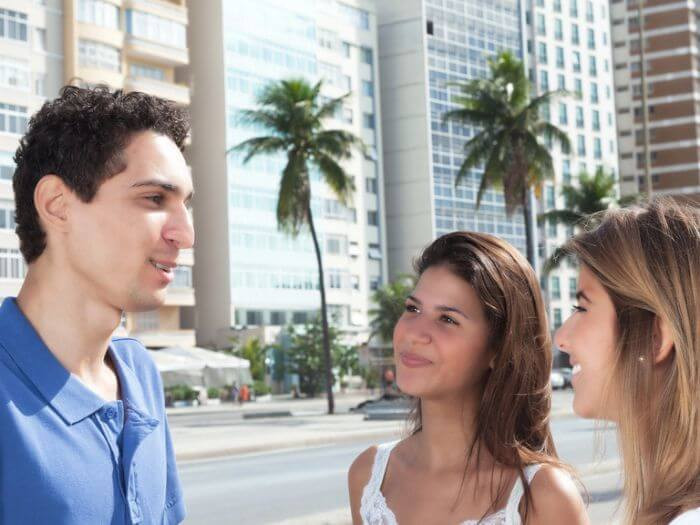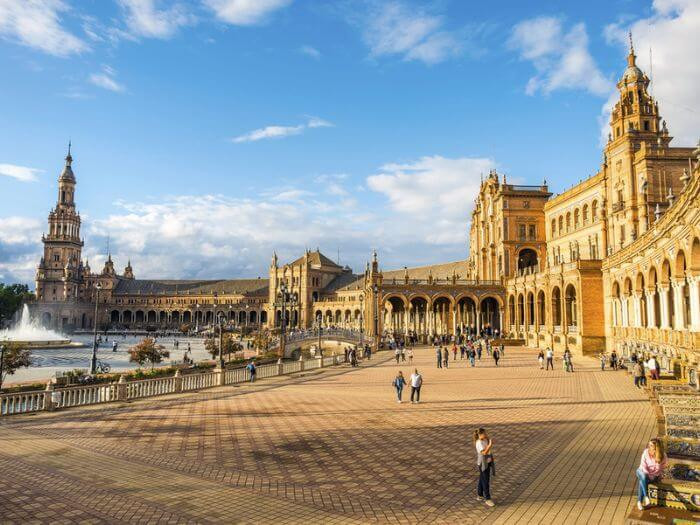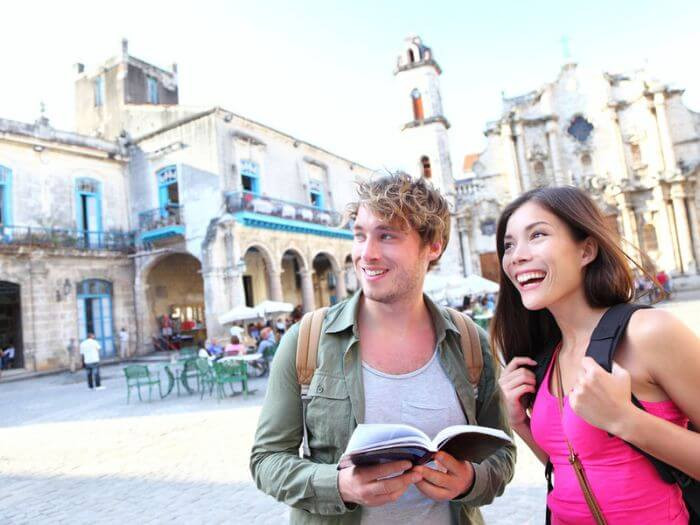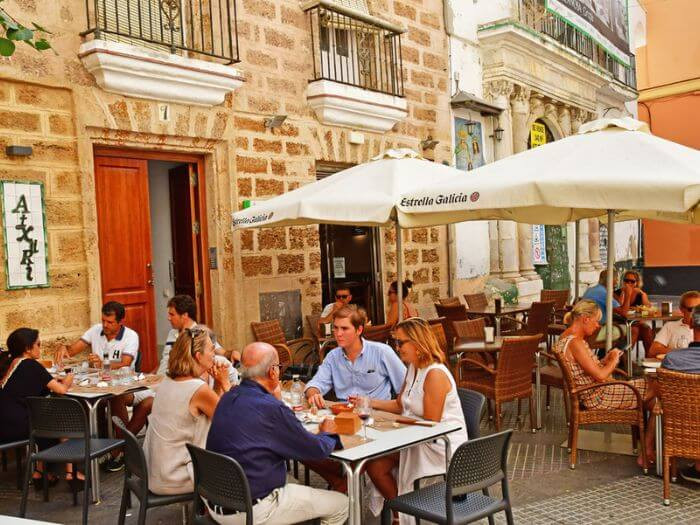Travel Expressions In Spanish are your gateway to a richer, more immersive experience in Spanish-speaking countries, and SIXT.VN is here to help you prepare. Whether you’re planning a visit to vibrant Vietnam or any other destination, knowing basic Spanish phrases can transform your journey from a simple vacation into a culturally enriching adventure. Unlock the beauty of communication and connection on your next trip with these essential travel terms, and let SIXT.VN be your companion in creating unforgettable travel memories.
1. Greetings To Use On Arrival
Knowing basic greetings in Spanish is like holding a key that unlocks doors to genuine interactions and deeper cultural understanding. Even a simple “¡Hola! ¿Qué tal?” (Hello, how are you?) can bridge the gap and invite warmth and connection.
 People greeting each other in a Spanish speaking country
People greeting each other in a Spanish speaking country
Here are some essential greetings:
- #1 ¡Hola! – Hello
- (O-la)
- #2 ¡Buenos días! – Good morning
- (BWAY-nos DEE-as)
- #3 ¡Buenas tardes! – Good afternoon/good evening
- (BWAY-nas TAR-des)
- #4 ¡Buenas noches! – Good night
- (BWAY-nas NOH-chays)
- #5 ¿Cómo está? – How are you? (formal)
- (KOH-moh eh-STAH)
- #6 ¿Cómo estás? – How are you? (informal)
- (KOH-moh eh-STAHS)
- #7 Bien, gracias – I’m fine, thank you.
- (bee-EN GRA-thee-as [Spain] / GRA-see-as [Latin America])
- #8 ¿Cómo te llamas? – What’s your name?
- (KOH-moh te YA-mas?)
- #9 Me llamo… – My name is…
- (May YA-moh… )
- #10 Mucho gusto – Nice to meet you
- (MOO-choh GOO-stoh)
Don’t forget common courtesies:
- #11 Por favor – please
- (por fa-BOR)
- #12 Gracias – thank you
- (GRA-thee-as [Spain] / GRA-see-as [Latin America])
If you have trouble understanding:
- #13 Yo (no) entiendo – I (don’t) understand
- (yo no en-tee-EN-doh)
- #14 ¿Habla inglés? – Do you speak English?
According to research from the Modern Language Association, speaking even a few phrases in the local language greatly enhances interactions with locals and enriches the travel experience.
2. How To Use The Verb “Querer” To Get What You Want
The verb querer (to want) is a powerful tool in your travel arsenal, according to the Cervantes Institute. In its first-person form, quiero (I want), this verb can help you navigate various situations with ease.
 Tourists at the Plaza de Espana, Seville, Spain
Tourists at the Plaza de Espana, Seville, Spain
Here’s how you can use it:
- #15 Yo quiero un menú – I want a menu
- (yo kee-EH-ro oon me-NOO)
- #16 Yo quiero un taxi – I want a taxi
- (YO kee-EH-ro oon taxi)
- #17 Yo quiero una cerveza – I want a beer
- (yo kee-EH-ro OO-na ser-BAY-za)
To be more polite:
- #18 Quisiera… – I would like…
- (kee-see-EH-ra)
3. How To Ask For and Understand Directions
Asking for directions is essential for navigating new places. The simplest way to ask where something is using ¿Dónde está? (Where is?), according to the Real Academia Española.
 Tourist couple travel in Havana, Cuba
Tourist couple travel in Havana, Cuba
Here are some examples:
- #19 ¿Dónde está el baño? – Where is the bathroom?
- (DON-day es-TAH el BAH-nyo?)
- #20 ¿Dónde está el banco? – Where is the bank?
- (DON-day es-TAH el BAN-koh?)
- #21 ¿Dónde está la calle [de Alcalá]? – Where is [Alcalá] Street?
- (DON-day es-TAH la KA-yay de al-cal-AH?)
When asking for directions, be polite:
- #22 Disculpe – Excuse me
- (Dis-KUL-pay)
- #23 Con permiso/Perdóname – Excuse me
- (Con per-MEE-soh / Per-DOH-nah-may)
- #24 Estoy perdido – I’m lost
- (eh-stoy per-DEE-doh)
Understanding directions is equally important. Here are some useful phrases:
- #25 Aquí – here
- (Ah-KEE)
- #26 Allí – there
- (ay-EE)
- #27 A la derecha – on the right
- (A la de-RE-cha)
- #28 A la izquierda – on the left
- (A la iz-kee-ER-da)
- #29 Derecho – straight ahead
- (De-RE-cho)
- #30 En la esquina – at the corner
- (En la es-KEE-nah)
- #31 A una cuadra – in one block
According to a study by the University of California, travelers who can ask for and understand directions in the local language report feeling more confident and less anxious while exploring new destinations.
4. How to Get Around
To navigate your destination efficiently, knowing basic transport phrases is essential.
 Tourists taking a selfie at the Plaça d
Tourists taking a selfie at the Plaça d
Here are some useful Spanish travel phrases:
- #32 ¿Dónde puedo encontrar un taxi? – Where can I get a taxi?
- (DON-day PWAY-doh en-kon-TRAR oon taxi?)
- #33 ¿Dónde está la parada de autobús más cercana? – Where’s the nearest bus stop?
- (DON-day eh-STAH la pa-RAH-dah de ow-to-BOOS mas ser-KA-nah?)
- #34 ¿Dónde está la estación de ferrocarril más cercana? – Where’s the nearest railway station?
- (DON-day eh-STAH la es-tah-see-ON de ferro-carr-EEL mas ser-KA-nah?)
- #35 ¿Cuánto cuesta un billete para … ? – How much does a ticket to … cost?
- (KWAN-to KWES-ta oon bee-YET-ay PA-ra …)
- #36 Un billete para … , por favor. – A ticket to … please.
According to statistics from the Spanish Tourism Institute (TURESPAÑA), tourists who use public transportation and local taxi services tend to spend more time exploring diverse neighborhoods and supporting local businesses.
5. How To Order Food at a Restaurant
Food is a significant part of any travel experience. Therefore, knowing basic restaurant phrases is crucial.
 People at the terrace of a restaurant in Cadiz, Spain
People at the terrace of a restaurant in Cadiz, Spain
Be prepared to hear these questions:
- #37 ¿Quieres algo para comer? – Would you like something to eat?
- (kee-EH-res AL-go PA-ra koh-MER?)
- #38 ¿Quieres algo para beber? – Would you like something to drink?
- (kee-EH-res AL-go PA-ra beh-BER?)
- #39 ¿Qué quieres comer? – What would you like to eat?
- (KAY kee-EH-res koh-MER?)
When reading the menu, you’ll encounter these categories:
- #40 una entrada – an appetizer
- (oo-na en-TRA-da)
- #41 un plato principal – a main dish
- (oon PLA-toh prin-si-PAL)
- #42 un postre – a dessert
- (oon POS-tray)
- #43 una bebida – a drink
- (OO-na beh-BEE-da)
When ordering, use quiero (I want) or quisiera (I would like):
- #44 una sopa – soup
- (OO-na SOH-pah)
- #45 una ensalada – salad
- (OO-na en-sa-LA-da)
- #46 el pollo – chicken
- (el POY-oh)
- #47 la carne – the meat (beef)
- (la CAR-nay)
- #48 un agua – water
- (oon AG-wa)
- #49 un vino tinto /blanco – red/white wine
- (oon BEE-noh TIN-toh / BLAN-koh)
- #50 una cerveza – beer
- (OO-na ser-BAY-sa)
- #51 un café – coffee
- (oon ka-FAY)
To ask for a recommendation:
- #52 ¿Qué me recomienda? – What do you recommend?
- (kay may re-kom-ee-EN-dah?)
If you have dietary restrictions:
- #53 Soy vegetariano/a – I’m a vegetarian
- (soy be-he-tah-ree-AH-noh/nah)
- #54 Tengo alergia a [las nueces] – I have an allergy to [nuts]
- (TEN-go al-ER-hee-ah a las noo-EH-ses)
To ask about the price and pay the bill:
- #55 ¿Cuánto cuesta? – How much is it?
- (KWAN-to KWES-ta?)
- #56 La cuenta, por favor – The bill, please
According to a survey by TripAdvisor, travelers who can communicate in the local language at restaurants report a higher satisfaction rate with their dining experiences.
6. Useful Spanish Question Words
Question words are indispensable for gathering information during your travels.
 Couple looking out over Machu Picchu, Peru
Couple looking out over Machu Picchu, Peru
Here are key Spanish question words to know:
- #57 ¿Quién? – Who?
- (kee-EN?)
- #58 ¿Qué? – What?
- (kay?)
- #59 ¿Dónde? – Where?
- (DON-day?)
- #60 ¿Cuándo? – When?
- (KWAN-doh?)
- #61 ¿A qué hora? – When/what time?
- (A kay AW-ra?)
- #62 ¿Por qué? – Why?
- (Por kay?)
- #63 ¿Cómo? – How?
- (KOH-moh?)
- #64 ¿Cuánto? – How much?
- (KWAN-toh?)
- #65 ¿Cuántos? – How many?
- (KWAN-tohs)
- #66 ¿Cada cuánto? – How often?
- (kah-dah KWAN-toh?)
- #67 ¿Por cuánto tiempo? – How long?
- (por KWAN-toh tee-EM-poh)
Learning these question words will enable you to form your own sentences and questions as you learn new vocabulary.
7. Essential Phrases For Accommodation
Whether you’re checking into a hotel, hostel, or guesthouse, knowing a few essential Spanish phrases can make your check-in process smoother and more enjoyable.
- ¿Tiene habitaciones libres? – Do you have any rooms available?
- Tengo una reserva a nombre de [Name]. – I have a reservation under the name of [Name].
- ¿A qué hora es el check-in/check-out? – What time is check-in/check-out?
- ¿Hay servicio de lavandería? – Is there a laundry service?
- ¿Puede recomendarme un buen restaurante cerca de aquí? – Can you recommend a good restaurant near here?
- ¿Cómo puedo conectarme al wifi? – How can I connect to the wifi?
- ¿Podría ver la habitación, por favor? – Could I see the room, please?
- ¿Incluye desayuno? – Does it include breakfast?
- Necesito una almohada/toalla extra. – I need an extra pillow/towel.
- ¿Puede llamar a un taxi para mí, por favor? – Can you call a taxi for me, please?
8. Shopping Essentials
Navigating local markets and shops is a great way to experience the culture and find unique souvenirs.
- ¿Cuánto cuesta esto? – How much does this cost?
- ¿Aceptan tarjetas de crédito? – Do you accept credit cards?
- ¿Tiene esto en otro color/talla? – Do you have this in another color/size?
- ¿Dónde puedo encontrar [item]? – Where can I find [item]?
- ¿Está en oferta? – Is it on sale?
- ¿Puedo probarme esto? – Can I try this on?
- ¿Me puede dar una bolsa, por favor? – Can you give me a bag, please?
- Estoy buscando [item]. – I am looking for [item].
- Es demasiado caro. – It’s too expensive.
- ¿Tiene cambio? – Do you have change?
9. Emergency Phrases
In case of an emergency, knowing how to ask for help or explain a situation is crucial for your safety and well-being.
- ¡Ayuda! – Help!
- Necesito un médico. – I need a doctor.
- Llama a la policía. – Call the police.
- Estoy perdido/a. – I am lost.
- Me han robado. – I have been robbed.
- ¿Dónde está la embajada/consulado de [country]? – Where is the [country] embassy/consulate?
- Tengo una emergencia. – I have an emergency.
- No me siento bien. – I don’t feel well.
- ¿Hay un hospital cerca? – Is there a hospital nearby?
- Necesito mi pasaporte. – I need my passport.
10. Cultural Phrases
Immerse yourself in the local culture by using phrases that show respect and appreciation for the customs and traditions of the country you’re visiting.
- ¡Qué bonito/a! – How beautiful!
- ¡Qué rico/a! – How delicious! (used for food)
- Salud. – Cheers (when toasting)
- Con permiso. – Excuse me (when passing by someone)
- ¡Qué tenga un buen día! – Have a good day!
- Muchísimas gracias. – Thank you very much.
- De nada. – You’re welcome.
- Encantado/a de conocerte. – Pleased to meet you.
- ¡Disfrute! – Enjoy!
- ¡Buen provecho! – Enjoy your meal!
11. Understanding Spanish-Speaking Culture
The Spanish-speaking world is full of rich traditions and customs. Here’s a glimpse to help you navigate with respect:
- Greetings: Handshakes are common, but cheek-kissing is standard between friends and family (one kiss in most of Latin America, two in Spain).
- Dining: Meals are often a social event. Don’t be surprised if they linger for hours. Tipping is customary, but amounts vary by country.
- Punctuality: While it varies, a relaxed approach to time is common in many Spanish-speaking regions.
- Gestures: Be aware that some gestures have different meanings than in your culture. For example, the “OK” sign is offensive in some Latin American countries.
- Language: Spanish has regional variations. Don’t be afraid to ask someone to clarify if you don’t understand.
- Respect: Show respect by using formal pronouns (usted) when addressing elders or people you don’t know well.
- Family: Family is highly valued. Be prepared to meet extended family members.
- Festivals: Spanish-speaking countries are known for vibrant festivals. Check local calendars and participate if you have the chance.
- Conversation: Expect lively conversations with interruptions. It’s often considered a sign of engagement.
- Humor: Humor is appreciated, but be mindful of cultural differences and avoid sensitive topics.
12. Common Spanish Slang
Sprinkling your conversations with a bit of local slang can be a fun way to connect with people and show you’re embracing the culture. But be cautious – slang varies greatly by region, and some words might be offensive in certain contexts.
General Slang:
- Vale: (Spain) Okay, alright. (pronounced “bah-leh”)
- Guay: (Spain) Cool, awesome.
- Chévere: (Latin America, especially Venezuela & Colombia) Cool, great.
- Bueno: (Widely used) Good, okay.
- Órale: (Mexico) Okay, let’s go, right on!
Greetings & Farewells:
- ¿Qué onda?: (Mexico) What’s up?
- ¿Qué pasa?: (Spain) What’s happening?
- Tío/a: (Spain) Dude/mate (literally uncle/aunt).
- Nos vemos: See you (informal).
- Hasta luego: See you later.
Describing People & Things:
- Majo/a: (Spain) Nice, friendly (person).
- Chulo/a: (Spain) Cool, cute. Can also mean “pimp” in some contexts, so be careful!
- Padre: (Mexico) Cool, awesome.
- Guate: (Guatemala) Cool, awesome.
- Cuate/Cuate: (Mexico) Friend, buddy.
- Jefe/a: (Latin America) Boss, but also used informally to address someone.
Food & Drink:
- Caña: (Spain) Small glass of beer.
- Tapa: (Spain) Small appetizer served with drinks.
- Menú del día: (Spain) Fixed-price lunch menu.
Expressions:
- ¡Qué fuerte!: (Spain) That’s shocking!
- No me digas: (Widely used) You don’t say!
- ¡Madre mía!: (Spain) Oh my god!
- Ahorita: (Latin America) Little now, can mean “soon” or “later” depending on context.
- Buena onda: Good vibes.
Tips for Using Slang:
- Listen first: Pay attention to how locals use slang before trying it yourself.
- Consider your audience: Slang is best used with people your age or younger.
- Be mindful of context: Some slang is informal or even vulgar, so use it appropriately.
- Don’t overdo it: A little slang goes a long way.
- Ask for clarification: If you’re unsure about a word or phrase, don’t hesitate to ask.
13. Tech Travel Terms
In today’s connected world, knowing a few tech-related Spanish phrases can be a lifesaver.
- Wifi: Wi-Fi (pronounced “wee-fee”)
- Contraseña: Password
- Internet: Internet (pronounced “een-ter-net”)
- Datos móviles: Mobile data
- Cargador: Charger
- Enchufe: Electrical outlet
- Aplicación: App (pronounced “ah-plee-kah-see-on”)
- GPS: GPS (pronounced “hay-pay-ays-ay”)
- Captura de pantalla: Screenshot
- Código QR: QR code
14. The Ultimate Guide to Getting Help from SIXT.VN
SIXT.VN understands the challenges travelers face and offers a range of services to make your trip seamless. Here’s how we can assist you:
- Trip Planning Assistance:
- Challenge: Planning a detailed trip can be overwhelming.
- SIXT.VN Solution: Our travel experts provide personalized itineraries tailored to your interests and schedule.
- Language and Cultural Barriers:
- Challenge: Overcoming language and cultural differences can be daunting.
- SIXT.VN Solution: We offer translation services and cultural insights to help you navigate confidently.
- Finding Reputable Services:
- Challenge: Ensuring you’re booking with trusted and high-quality service providers.
- SIXT.VN Solution: We partner with vetted hotels, transportation services, and tour operators.
- Navigating Local Transportation:
- Challenge: Getting around efficiently and safely in a new city.
- SIXT.VN Solution: We provide reliable airport transfer services and assist with booking local transportation.
- Booking Assistance:
- Challenge: Quickly and conveniently booking accommodations, flights, and activities.
- SIXT.VN Solution: Our platform offers easy booking for hotels, flights, tours, and airport transfers.
- Airport Transfer: Reliable and comfortable transportation to and from the airport.
- Hotel Booking: A wide selection of hotels to suit your budget and preferences.
- Tour Booking: Expertly guided tours to explore the best of Hanoi and beyond.
15. Booking and Planning Made Easy with SIXT.VN
SIXT.VN is your trusted partner for seamless travel planning in Vietnam, especially in Hanoi. Here’s how you can leverage our services to create unforgettable travel experiences:
1. Personalized Travel Itineraries:
- Challenge: Creating a travel itinerary that matches your interests and available time.
- SIXT.VN Solution: Our travel experts work with you to design a personalized itinerary, ensuring you see the best of Hanoi and its surroundings.
2. Airport Transfer Services:
- Challenge: Navigating airport transportation can be stressful.
- SIXT.VN Solution: We provide reliable and comfortable airport transfer services, ensuring a smooth start and end to your trip.
3. Hotel Booking Services:
- Challenge: Finding the perfect accommodation that fits your budget and location preferences.
- SIXT.VN Solution: SIXT.VN offers a wide selection of hotels, from budget-friendly options to luxury stays, all in prime locations.
4. Tour Booking Services:
- Challenge: Discovering and booking reputable tours to explore Hanoi’s top attractions.
- SIXT.VN Solution: We offer a variety of expertly guided tours, allowing you to experience the best of Hanoi’s culture, history, and cuisine.
5. Flight Booking Services:
- Challenge: Finding affordable and convenient flight options.
- SIXT.VN Solution: Our flight booking service helps you find the best deals and schedules to suit your travel plans.
6. Cultural Immersion and Language Support:
- Challenge: Connecting with locals and understanding the culture can be difficult without language skills.
- SIXT.VN Solution: We offer language assistance and cultural tips to enhance your interactions and enrich your experience.
How to Book with SIXT.VN:
- Visit our Website: Go to SIXT.VN to explore our range of services.
- Contact Us: Reach out via phone or WhatsApp at +84 986 244 358 for personalized assistance.
- Get a Free Consultation: Fill out our online form to receive a free travel consultation.
Why Choose SIXT.VN?
- Convenience: Book all your travel needs in one place.
- Reliability: Trust in our vetted services and expert guidance.
- Personalization: Enjoy customized itineraries and tailored support.
- Local Expertise: Benefit from our deep knowledge of Hanoi and Vietnam.
With SIXT.VN, planning your dream trip to Vietnam is easy, convenient, and stress-free. Let us handle the details so you can focus on making unforgettable memories.
- Address: 260 Cau Giay, Hanoi, Vietnam
- Hotline/WhatsApp: +84 986 244 358
- Website: SIXT.VN
16. Spanish Travel Phrases FAQs
What are 10 vacation phrases in Spanish?
Here are ten essential vacation phrases in Spanish:
- ¡Hola! (Hello)
- Por favor (Please)
- Gracias (Thank you)
- Disculpe (Excuse me)
- ¿Habla inglés? (Do you speak English?)
- Quiero un menú (I want a menu)
- ¿Dónde está el cajero automático? (Where is the ATM?)
- ¿Cuánto cuesta? (How much is it?)
- ¿Dónde puedo encontrar un taxi? (Where can I get a taxi?)
- Un billete para [destination], por favor. (A ticket to [destination], please)
What is a popular Spanish phrase?
Hola (Hello) is a basic greeting. Other popular phrases include Buenos días (Good morning), Buenas tardes (Good afternoon), Buenas noches (Good evening), Gracias (Thank you), Por favor (Please), and Perdón (Sorry).
What is the vocabulary for travelling in Spanish?
Key travel vocabulary includes:
- Equipaje (Luggage)
- Maleta (Suitcase)
- Mochila (Backpack)
- Pasaporte (Passport)
- Boleto (Ticket)
- Aeropuerto (Airport)
- Estación (Station)
- Monumento (Monument)
- Museo (Museum)
- Plaza (Square)
- Parque (Park)
- Edificio histórico (Historic building)
- Cine (Cinema)
- Restaurante (Restaurant)
- Catedral (Cathedral)
- Iglesia (Church)
- Puente (Bridge)
- Zona comercial (Shopping area)
What are the 7 most common words to survive in a Spanish-speaking country?
The seven most common words are:
- ¡Hola! (Hello)
- Por favor (Please)
- Gracias (Thank you)
- Disculpe (Excuse me)
- ¿Dónde? (Where?)
- ¿Cuánto cuesta? (How much is it?)
- Quiero… (I want…)
Are there regional differences in Spanish travel phrases?
Yes, Spanish has many regional variations. Vocabulary, pronunciation, and even grammar can differ between countries and regions. For example, the word for “bus” can be autobús, camión, guagua, or colectivo depending on the country.
How can I improve my Spanish pronunciation before traveling?
Use online resources like Forvo or SpanishDict to hear native speakers pronounce words and phrases. Practice mimicking their pronunciation, paying attention to stress and intonation.
What are some common mistakes English speakers make when speaking Spanish?
Common mistakes include:
- Incorrect verb conjugations.
- Using the wrong gender for nouns.
- Literal translations from English.
- Mispronouncing sounds like the “r” and “j.”
- Forgetting to use the personal “a” when the direct object is a person.
Are there any cultural differences I should be aware of when speaking Spanish?
Yes, politeness is highly valued. Use formal pronouns (usted) when addressing elders or people you don’t know well. Avoid sensitive topics and be mindful of gestures that may have different meanings than in your culture.
Where can I find resources to learn more Spanish travel phrases?
- Language learning apps (Duolingo, Babbel)
- Online courses (Coursera, Udemy)
- Travel phrasebooks (Lonely Planet, Berlitz)
- Language exchange partners (HelloTalk, Tandem)
- YouTube channels dedicated to Spanish language learning.
How important is it to learn Spanish travel phrases before visiting a Spanish-speaking country?
Learning even a few basic phrases can greatly enhance your travel experience. It shows respect for the local culture, makes it easier to navigate daily situations, and can lead to more meaningful interactions with locals.
17. Embark On Your Adventure
 A woman sitting on a rock looking at Toledo, Spain
A woman sitting on a rock looking at Toledo, Spain
Learning Spanish travel phrases can greatly enhance your travel experiences. If you’re planning a trip, SIXT.VN can help with personalized itineraries, reliable transportation, and trusted accommodations. Start your adventure with confidence and ease, knowing you have the support of SIXT.VN every step of the way. Contact us today to plan your next unforgettable journey!



